2007 VOLKSWAGEN JETTA Belt
[x] Cancel search: BeltPage 168 of 477

The airbag system is monitored electronically 10 make cenain i t is functio ning properly all
t ime s. Each time you turn o n th e ig ni tion,
airbag system indica to r lig ht w ill co me on for a
few seco nds (self diagnost ics).
T he side airbag syste m sup pleme nts rhe safety
be lts and can help to reduce the risk of inj ur y
the dr iv er's a nd front passe nger's upper torso on sid e of th e vehicle that is stru ck in a sid e co l
li sion. The airbag inflate s on ly in sid e impa cts
and onl y when the veh icle acce leration reg is
t e red b y the control unit is high en ough. If
rate is below reference value programm ed
i n to co ntr ol u ni t, t he side airbag s not be
trigg ere d , eve n though the ca r ma y be badly
damag ed as a r esult of the co llision. It is
pos
s ible d efin e an airbag trigger ing rang e th at
w ill cover eve ry possible ang le of impact, sin ce
t h e ci rc u ms ta n ces will vary co nsiderably be
twee n one collision and anot her. lrnpona nl fac
include, for example, the na tu re (har d or
s oft ) of th e impacting objec t, a ngle of im
pact, vehicle speed, etc. 46, "Impo rta nt
s afet y in structio ns for the side a irbag system ".
As ide from th eir normal safety function, saf ety
belts
to h elp k eep the dri ver or front pas
senger in posit io n in a side colli sio n so th e
s id e airb ags can prov ide prot ection whe n
inflate. Safe ty belt s also help to keep rear seat
pas seng ers in po sition so that optional rear seat
s id e airbag s can prov ide protection in a sid e co l
li sio n i n w hic h th e side air b ag inflates.
T he a irbag syste m is not a subst itute for your
safety belt. Rather, it is part of t he overa ll occu
pant re straint syste m in your vehicle. A lways re
memb er
the airbag syste m can only help to
pro tec t yo u if you are wearing your safe ty b elt
and wearing
properly. This is an other rea son
why you sho uld alwa ys wear your safe ty belt s,
n o t ju st b ecau se th e
re quir es you do so 13 , bel ts" .
It is im portant 10 re mem be r that wh ile th e su p
p lemen tal side airbag system is designed to help
Booklet 2.1 Safety first
reduce the likelih ood of seriou s injuri es, other
injuries, for example, swelling, bruising, and
mi nor abra sions can a lso be associated w it h
th ese airbags. Remember t oo , side airbags w ill
dep loy o nly once an d on ly in certai n kinds of ac
ciden ts - your safety belt s are always th ere to
offer protec tion.
Ve hicle dam age, repa ir cost s or even
lack of
ve hicle da mag e is no t necessa rily a n indicatio n
of prope r airbag operation. In some collis ions,
both front and side airbag s may inflate. Re
mem ber too, tha t airbag s w ill dep loy only once
a n d only in certain kind s of collis io ns - your
safety belt s ar e always there to offer protection in
t h ose acciden ts in whic h ai rb ags a re not sup
po sed to deploy or whe n
have al ready de
p loye d.
Th e side airbag sy stem
will not b e trigg ere d
• if th e igni tion is sw itc hed off,
• in side collisions when
accelerat ion mea
s ured by th e sensor is too low ,
• in front-en d co llisio ns,
• in rear -end collisions,
• in rollove rs.
In some types of accidents
Sid e Cur
tain Pro tection and sid e airbag s may be tr ig
gered together.
WARNING
• Safety belt s a nd lh e a irb ag sys te m will onl y
p rov ide prot ectio n when occ upant s a re in the
co rrec t se atin g po sition
13, "Safety
b elt s" .
• If the air b ag in dicator light comes o n when
the vehicl e is bein g use d, h ave the sys te m in
spec te d imm edi ate ly by yo ur Vol kswage n
d eal er. Th e side a irb ag sys te m m ay not wor k
prop erl y eve n wh en th e vehicle acce le ratio n
in a side colli sion i s high en ough
10 ac tiva te
th e a irbag
Airbag system 45
Page 169 of 477
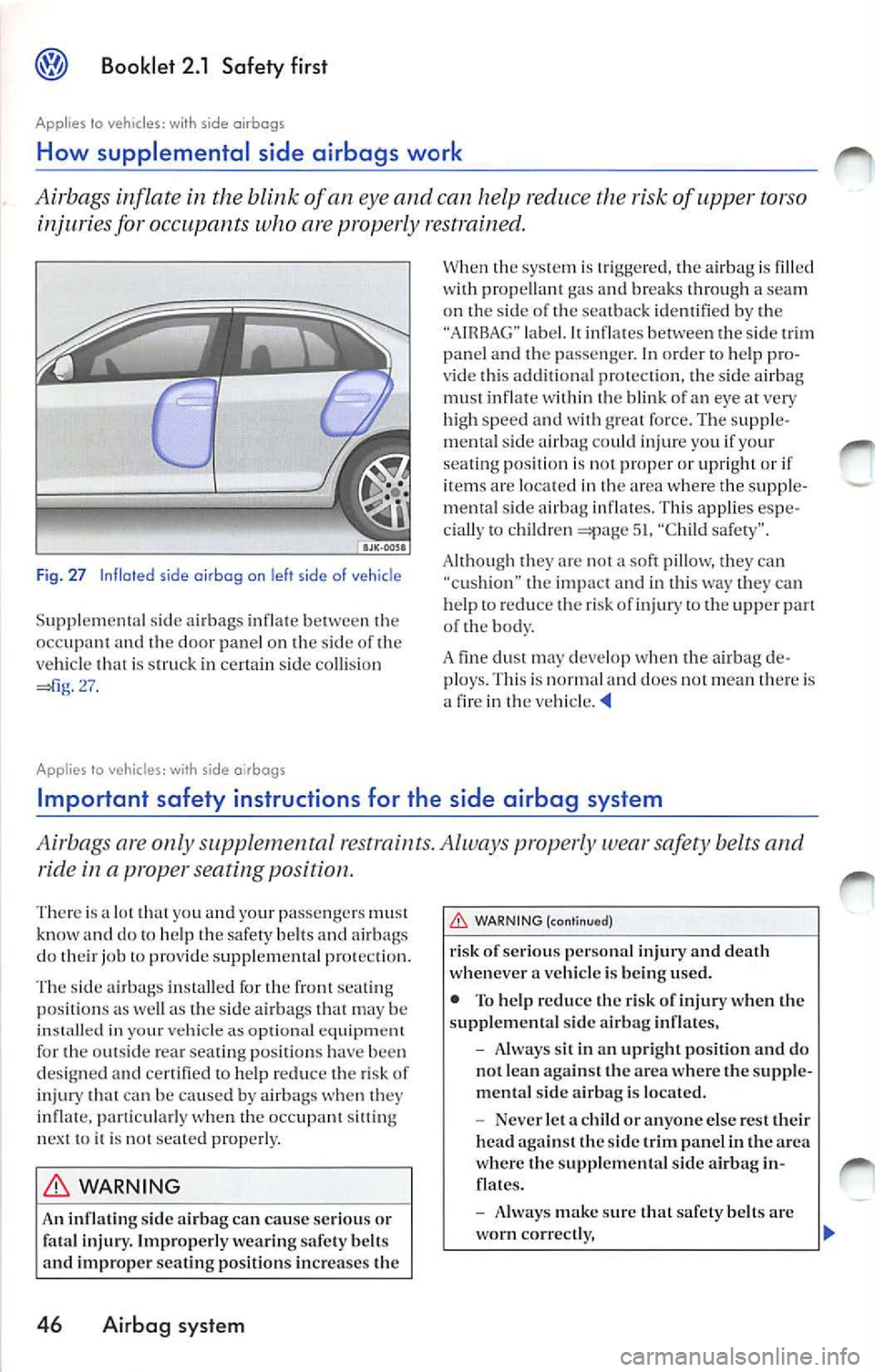
Booklet 2.1 Safety first
Applies to vehicles: with side airbags
How supplemental side airbags work
Ai rbags inflate in the of an eye and can help reduce the risk of upper torso
injuries fo r occupants who are properly rest rained.
F ig . 2 7 Inflate d side air bag an left side of vehicle
Suppl em ent al sid e airbag s infl ate be tw ee n th e and !h e doo r pan el o n sid e of ve hicl e is s tru ck in certain sid e co llisio n 27 .
Applies to vehicles: with side airbags
When the syste m is tri gger ed, th e airbag is fill ed
with prop ellan t ga s and br eak s throu gh a se am
o n the s ide o f th e sea t b ack id entifi ed by th e
" A IH BA G" lab el. It
betw een the side p anel and th e passe nge r. In ord er t o help pro
v id e thi s add itional protec tion, sid e a irba g
mu st infl ate within th e blink of an eye at very
hi gh sp ee d and with grea t fo rce . Th e suppl e
m ental sid e airba g could i njur e you if your
seating po sit io n is
11 0 1 prop er or upr ight or if
i t e m s are lo cat ed in ar ea wh ere t he sup ple-m ent al sid e airba g inflat es. Th is applie s espe-
cially to children 5 1, "C hild safe ty".
A lth ough th ey arc no t
so ft pill ow, th ey ca n
"c ushi on " th e im pact and in thi s way they c an
h elp t o re du ce the risk of inju ry to th e upp er p an
o f th e bod y.
fin e du st ma y when th e airba g de
p loys. This is no rmal and doe s not mean th ere is
a fir e in the v eh icl e.
Important safety instructions for the side airbag system
Airbag s are only supplem ental res traint s. Always prop erl y wear safety belts and
ride in a proper seating posit ion.
Th ere is a lo t thal you and your pa ssengers mu st
know and do help th e safety belts and a irbag s
do their job lO provid e supp lem ental protec tion.
Th e sid e airbag s insta lled for th e front sealin g
p os itions as w ell as th e s ide airba gs that ma y be
in stall ed in your vehicl e as op tio nal equipm ent
fo r th e outsid e re ar se a tin g po siti ons hav e bee n
d es ig n ed and certifi ed t o help r edu ce the r is k of
injur y th at ca n b e caused by airba gs when th ey
inflat e,
wh en the oc cup ant siuin g
n ex t to it i s no t seat ed prop erly .
WARNING
An in flatin g s ide a irbag ca n cau se serious or in jury. Improper ly wear ing safety belts
an d i mproper seating pos itions i ncreases the
46 A irbag system
WARN ING (continued)
ris k of se riou s perso nal inju ry and d eath
w heneve r a ve hicle is bein g use d.
• To help re duce the risk
inju ry w hen th e
su ppl em ent al sid e airb ag infl ates,
-
s it in an u prig ht pos ition and do
n ot lea n aga inst th e a rea w here th e s up ple
me nta l side airbag is located.
- Never let a ch ild or an yo ne e lse res t th eir
h ead aga ins t th e side t rim p anel in th e area
w here th e s up pl eme ntal s id e a irbag in
fla tes .
- Always make su re that safe ty belt s arc
wo rn correc tly,
Page 171 of 477
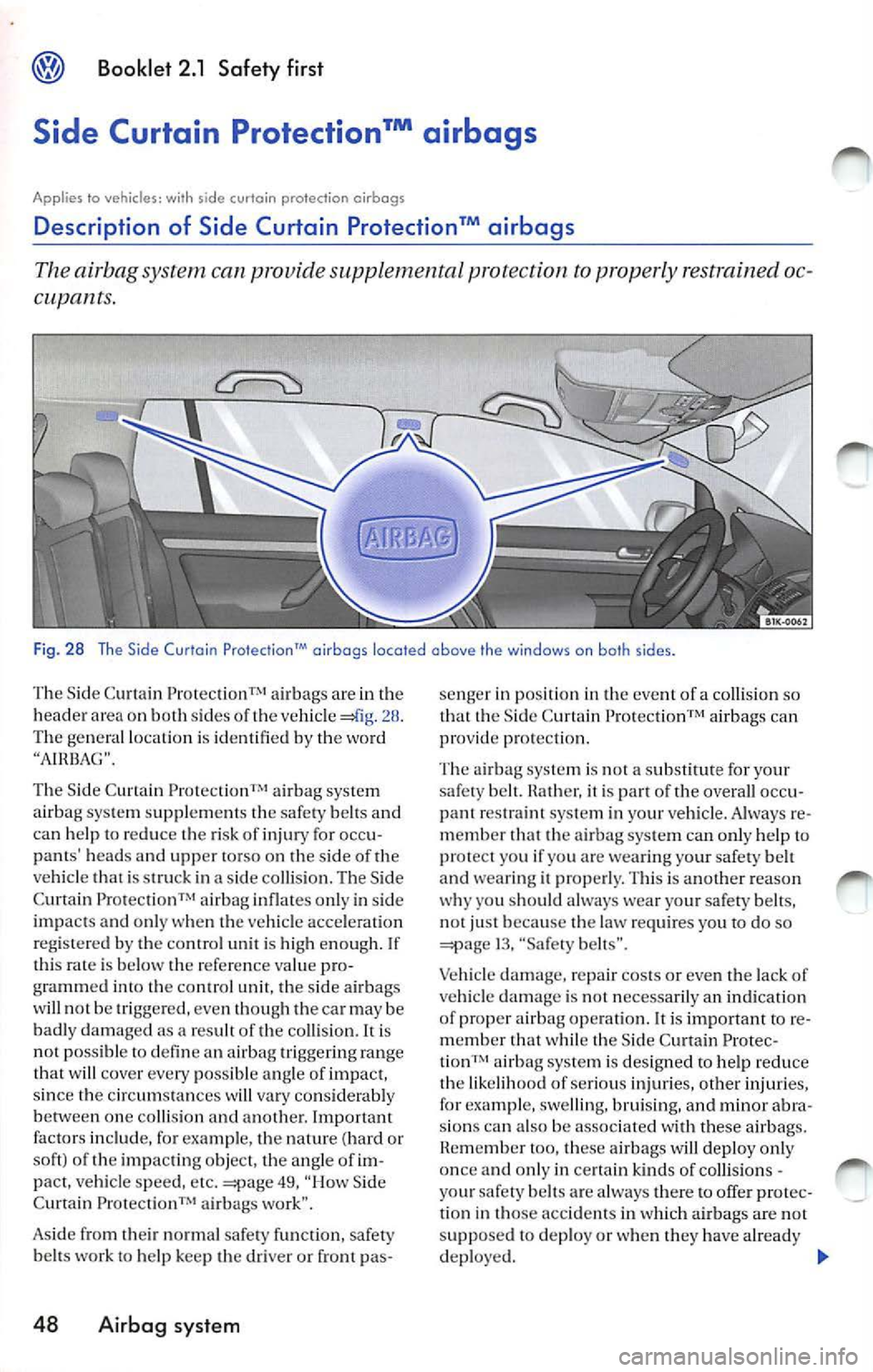
Booklet 2.1 Safety first
Side Curtain Protection
provide supplemental protection to properly restrained oc
cupants.
Fi g. 28 Th e Side Curtain Pro tec tio n™ a irba gs loca ted above the w indows on bo th s ides .
The S ide Curt ain airbags are in th e
header area on both side s of the veh icle 28 .
Th e general loca tion is iden tified by the word
The Side Curtain Protec tion airbag system
a irba g sys te m suppl eme nts the safe ty belts and
ca n help to r educe the risk of injury for occu
pant s' heads and upper tor so on the sid e of the
ve hicl e th at is s tru ck in a side collisio n . The Side
C urtain
airbag inflates only in sid e
impa cts and only when the veh icle acce le ration
regi stere d by the control unit i s high enough. If
thi s rate is below the refe rence value pro
grammed into th e co ntrol unit, the side airba gs
w ill not be tri gge re d , eve n though the car may be
badly damag ed as a resu lt of th e co llision. It is
not pos sib le to define an airbag triggering range
that will cover eve ry po ssible ang le of impact ,
s inc e th e circum stanc es will vary co nsidera bly
be tween o ne co llisio n and another. Important
fa ctors include , for example, the nat ure {hard or
so ft) o f the impactin g
the ang le of im
pa ct, vehicle speed, etc. 49, "How Sid e
Curtain Protectio n airbags work" .
As ide fr om the ir nor mal sa fe ty function , safety
b elt s wo rk to he lp keep the dr iver or front pas -
48 Airbag syste m
senge r in po sit io n in the event of a co llision so
that t he S ide Curta in Protectio n™ a irbags ca n
provid e prot ection .
Th e airbag syste m is not a subs titut e for your
safe ty belt. Hath er, it is part of the overall occu
pant r estraint system in you r ve hicle. Always re
memb er that the airbag system can only help to
protect you if you are wearing your safety belt
and wearing it prop erl y. This is another reaso n
you sh ould alwa ys wear your safety belt s,
n o t ju st becau se the law r equir es you to do so
13, "Safety belts".
Veh icle damage, repair costs or eve n the lack of
vehicle damage is not necessa rily an indi cation
of prop er airbag operation. lt is imp orta nt to re
m emb er that while the Side Curtain Protec-
ti on
airbag system is de sig ned to help reduce
the like lihood of se rious injuries, oth er injuri es,
for examp le, swe lling, bruis ing, and minor abra
s ions can als o be assoc iated w it h th ese a irbags.
too, these airba gs w ill deploy onl y
once and on ly in certain kinds of collisions
yo ur safet y belt s are a lways there to offer prote c
ti on in thos e accide nts in whi ch airbags are not
s upp osed
depl oy or when they hav e al rea dy
d eployed .
Page 173 of 477
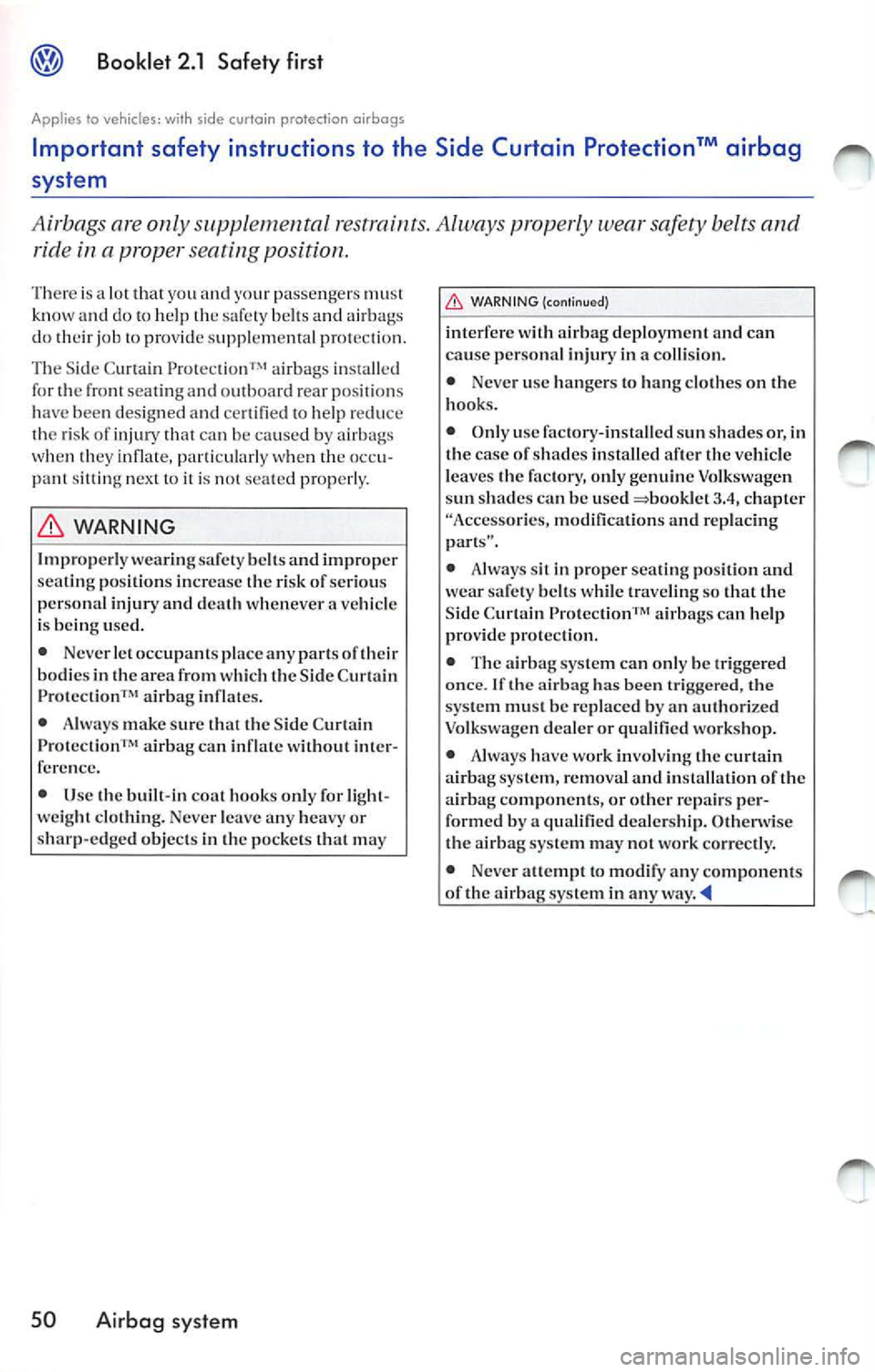
Booklet 2.1 Safety first
Applies to vehicle s: with side cvrtoin protection airbags
Important safety instructions to the Side Curtain Protection™ airbag
system
Airbags a re only supplemental restraints. Always properly wear belts and
ride
a proper position.
Ther e is a lot that you and yo ur passeng ers k n ow and do to help th e safety belts and a irbag s
d o their job 10 prov id e s uppl em ental prot ection .
Th e
Curtain Prot ectio n1
·" airbag s in stall ed
for th e front seating and outb oard re ar p osition s
ha ve bee n d esign ed and certifi ed to help re du ce
the risk of injury 1ha1 can b e caused by
when infla te , p ar tic ularly when the occunext to it i s 1101 se at ed prop erl y.
WA RNING
lmproperlyweari ngsafety belts an d im proper
sea ling pos itions increase risk of serious
perso nal inj ury and d eath when ever a vehicle
i s be ing use d.
• Never le t occupa nts pl ace an y parts of their
bod ies in th e a rea from which the S ide Cu rtai n
P rotcct ion T" airbag infl ates.
• Always make sur e that
Si de Cur tain a ir bag ca n infl ate wit ho ut i nt er
fe re n ce .
• Use the bu ilt-in coa t hooks o nly
li ght
we ig ht clo th in g. Never leave any heavy or
shar p-edge d ob jects in
pockets may
SO Airbag s ystem
&, WARN ING (continued)
int erfe re w ith airb ag de ploy ment and can
ca use perso nal in jury in a co llision.
• Neve r use han ge rs to hang cl oth es o n the
hooks.
• O nly use fac to ry- in stall ed sun sh ad es or, in
th e case of sh ades insta ll ed aft er the ve hicl e
l eaves the fac to ry, onl y ge nuin e Volk swagen
s un sh ades ca n be use d
3.4, ch apt er
"Accessor ies, mod ifications and rep la cin g
par ts".
• A lways sit in
seat ing pos it io n and
w ear sa fe ty belts w hile t raveling so that th e
S id e Cur tain Pro tec tion
1
"M a irb ags can help
p rov ide pro tec tion .
• T he airbag system can onl y be trigge re d
o n ce. If
air bag has th e
sys te m be rep laced by a n auth ori zed
Vo lkswage n dealer or q uali fied w ork sh op.
• Always have wor k inv olvin g
curt ain
a irb ag sys te m , re m ova l and in sta ll atio n o f th e
a irbag compo nen ts, or other re pair s pe r
formed by a qua lified dea lers hip . Ot henv ise
t h e air b ag syste m may not wor k correc tly.
• Never att em pt t o m odi fy any co mpon en ts
of the a irbag sys tem in a ny way.
Page 174 of 477
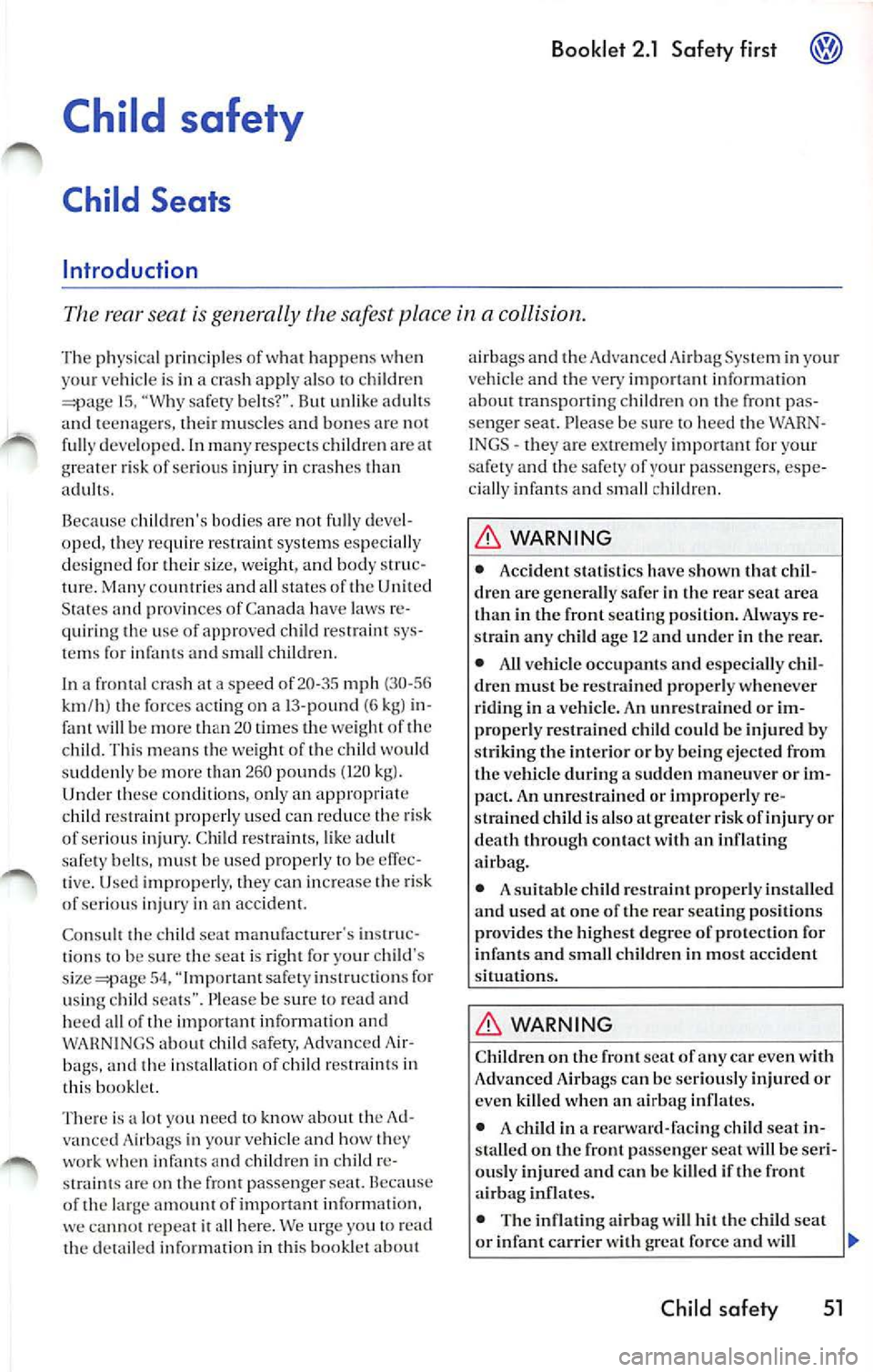
Booklet 2.1 Safety first
happ en s w hen
yo ur vehicle is in a cras h appl y also to chi ldren
15 , sa fety belt s?". But unlik e adult s
a nd t eenagers, the ir mu scles and bones are not
f ull y deve lo ped. In man y res pe cts child ren are a t
greater risk of serious inju ry in cras hes than
adult s.
13ecausc childr en' s bodi es are not full y deve l
oped, they re quir e re straint syste m s es peciall y
d esig ned for their size, weight, and
struc
tu re. Many co untries and all sta tes of the Unit ed
S ta tes a nd pro vin ces of Ca nad a hav e la ws re
qui ring the use of ap proved child restra int sys
tem s fo r infan ts and sm all childr en.
In a fron tal cras h at a s peed of20-35 mph (30-56
km /h ) th e forces actin g on a 13-pou nd (6 kg) in
fant w ill be m ore
20 tim es the we igh t of the
child. This m eans th e we ig ht of t he c hild would
s udd enl y be mor e th an 2 60 pound s (120 kg).
Under these co nditions, o nly a n appropr iat e
child res traint properl y use d can re du ce the risk
of serious injur y. Child rest rain ts , lik e adu lt
belt s, mu st b e used properl y to be effec
t ive . U sed im pro per ly, they ca n increase the risk
of serious injur y in an
Consu lt the chil d sca t manuf ac!Ur er's instru c
tion s to b e sure th e seat is right for your chil d's
s ize
54 , " Imp ort ant safety inst ructi ons fo r
u sin g child seats". Please be sure to rea d and
h ee d all of th e im porta nt inform atio n and
WAHN INGS
c hild safety, Advanced Air
bags , the in sta lla tion of child r estraint s in
thi s
is lot you need to kn ow about the Ad
van ced in your vehicl e and how th ey
wo rk when infants c h ild re n in child re
strai nts arc o n the front passenge r sea t.13eca use
of the la rge amo unt of im portant inform ati on .
we cann ot re p eat it all here . We urge you to re ad
th e deta iled inf orm ati on in thi s booklet abo ut a
irba gs and the i\dva nced A irbag Sys te m in yo ur
veh icle an d th e very import ant inform ati on
abo ut transport ing c hildren on th e front pas
se ng er sea t. Pl ease be sure to heed the WARN
I NGS -th ey are ex trem ely imp ort ant for yo ur
sa fe ty and th e safety of yo ur pa sse ngers , espe
ciall y in fants and sm all childr en .
WARNING
• Accident statistics have shown that chil
dr en are genera lly sa fer in th e rear seat area
t h an in the front seating po sition. Always re
s train any ch ild age 12 and und er in th e re ar.
• AU vehicle occ upant s and especially chil
dr en mu st be r estrain ed properl y w hen ever
riding in a vehicle. An unr estrain ed or im
properly res trained ch ild could be injured by
striking the interior or by being ejec ted from
the vehicle during
sudden maneuver or im
pact. An unrestrain ed or improperly re
stra ined ch ild is also at greater r is k of injury or
death through contact with an inflating
airbag.
• A sui table chil d re straint properly in stalled
a nd u sed at on e of th e rear seati ng positio ns
pro vid es t he hi gh est degre e of protection for
infants and small children in mo st accident
s ituation s.
WARNING
Childr en on the front s cat of any car even with
i\dvanced can be seriously injured or
eve n kill ed when an ai rbag inflat es.
• A ch ild in
re arward -facing child seat in
s ta lled on the front p assenger seat will be seri
o usly injur ed and can b e killed if the front
a irbag inflate s.
• The inflati ng airbag
hit th e ch ild seat
or infant carrier with great fo rce a nd will II>-
Child safety 51
Page 176 of 477
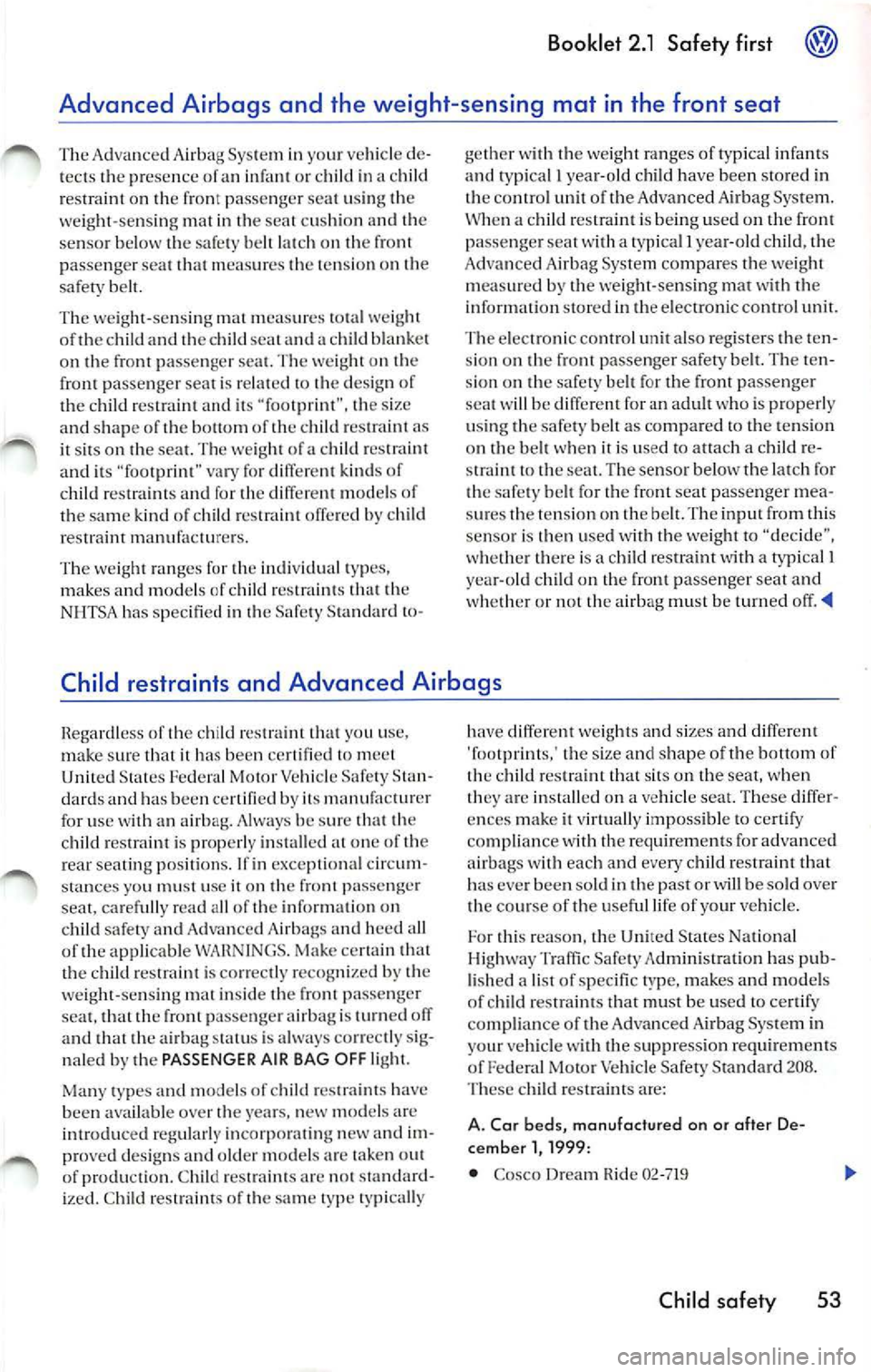
Booklet 2.1 Safety first
Advanced Airbags and the weight -sensing mat in the front seat
The A dva nced Airba g Sys te m in yo ur vehicl e de
t e cts the presence of an infant or ch ild in a child
r estrai nt on th e fron t passe nger sea t usin g th e
weig ht-sensin g mat in the sea t cushi on and the
se nso r below the safe ty belt lat ch on the front
p assenger seat th at m eas ures the te nsion on th e
belt.
The weigh t-se nsi ng m at m eas ures
we ig ht
o f th e c hild and the child seat and a child bla nk et
on the front pa sse nge r sea t. The weight on th e
front passe nger seat is re la ted to th e de sig n of
the child restrai nt and its "foo tprint ", the s ize
an d sh ap e of the b ou om of the c hild res traint a s
it sits on the se at. The we ig ht of
ch ild res traint
an d it s "foot print " vary for differe nt kind s of
child re straint s and for th e diffe re nt m odels of
t h e sam e kin d o f child r estraint offere d b y child
re straint manufa ctu rers.
Th e weig ht ranges for the indi vidual ty p es,
makes and m odels of c hild res trai nts th at th e
N HT SA has sp ecified in th e Safe ty Standa rd to· ge
ther w ith th e weight ra nges of typi ca l in fants
and ty pic al I ye ar-old child have bee n sto re d in
t h e co ntrol un it o f the Advanced Airb ag Sys te m.
Whe n a c hild res traint is bei ng use d on th e fro nt
passe nge r sea t w ith a ty p ica l
1 ye ar- old child , th e
A dvanc ed Ai rbag System compares the weight
mea sur ed b y th e we ig h t-se nsi ng ma t w ith the
informa tion stored in the elec tro nic con trol unit.
T he elec troni c control u nit al so reg is te rs th e ten
s ion on th e front passeng er sa fe ty be lt. T he te n
s ion on th e sa fety belt for the front pa ssenger
sea t
be different for ad ult is prop erl y
u sin g th e s afety belt as compar ed to the te n sio n
o n th e be lt
it is use d to att ach a child r e
s traint to th e seat. Th e senso r be low the la tc h fo r
th e safe ty belt for t he front seat passe nger mea
s ur es the tensio n on th e be lt. The input from thi s
se nso r is th en use d wit h the weig ht t o "d ec ide ",
w hethe r th ere is a chil d res tra int with a typica l
1 year-old ch ild on the front passe nger seat and
w he th er or not th e airb ag mu st b e turn ed
Child restraints and Advanced Airbags
Hegar dlcss of the ch il d re stra in t that you use,
mak e sur e th at it has been ce rtifi ed me et
United States Fe dera l Motor Vehicl e Saf ety S tan
dard s and has been ce rtified by its m anufa ctu re r
for use w ith a n airb ag. /\!ways be sur e that the
c hild r estrai nt i s pro perly
at o ne of t he
r ear sea ting pos itio ns. I f in exce ptional circu m
s ta nces you m ust u se it o n the fro nt pa ssenge r
sea t, car efull y read all of th e in for matio n on
c hild safety and Adva nced Airbags and hee d all
of th e a pplicabl e
IN GS . Mak e ce rtain that
t h e c hild res traint is cor rec tly reco gnized by th e
we ig ht- sensin g mat in side the front passe nge r
sea t, th at th e front p assenge r air b ag is turn ed off
and th at the a irb ag stat us is always correc tly s ig
n aled by th e PASSENGER AIR BAG OFF light.
Many ty p es an d m odels of ch ild res 1rai111 s have
b ee n avai lab le ov er th e years ,
models are
introdu ced r egularl y in cor poratin g new and im
proved des ign s and old er m odels are take n out
of produ cti on. Chil d res train ts are no t sta ndard
i zed. C hild restra ints o f the sam e ty p e typi ca ll y h
ave diff ere nt weight s and sizes and differ en t
'foot prin ts ,' t he s ize and sh ape of th e bott om of
th e c hild res train t th at s its on the seat, whe n
th ey are installed on a vehi cle seat. Th ese differ
e nces mak e it virt uall y impos sib le to cert ify
co mplian ce with th e re quireme nts fo r adva nce d
a ir bag s wit h ea ch and every child res traint that
h as eve r bee n so ld in the pa st or will be sold ove r
th e co urse of the use ful life of yo ur vehicle.
For thi s reaso n, th e Uni te d Sta tes N ati ona l
Hi gh way Tra ffic Sa fe ty A dmini strat io n has pub
li sh ed
li st of sp ecifi c type, makes and mode ls
of child restr ai nt s that must b e use d t o ce rti fy
co mpliance of the Advan ced Air bag Syste m in
y our vehicl e w it h th e s uppre ssio n r equir em en ts
of Fe d era l Moto r Ve hicle Safety S tandard 208.
Th ese c hild restra ints are:
A. Car beds, manufactur ed an or after De·
cember 1, 1999:
• Cos co Dre am Rid e 02-7 19
Child safety 53
Page 177 of 477
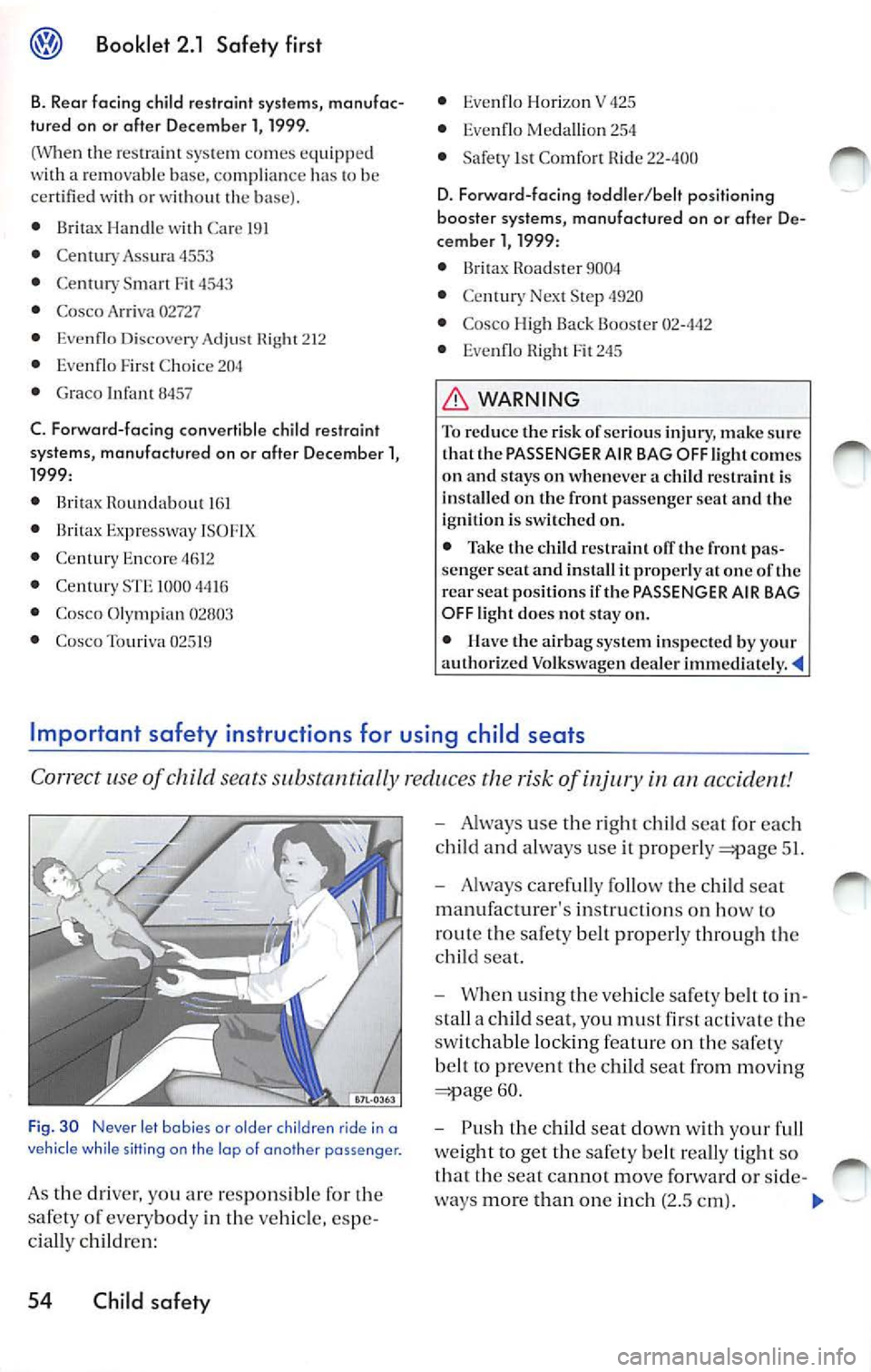
Booklet 2.1 Safety first
8. Rear facing child restraint systems, manufac
tured on or alter December l, 1999.
( W hen the res tra in t sys te m comes e quipp ed
w ith a re mo vable ba se, co mpli ance ha s to be
ce rtified with or wit hout the ba se).
• Britax Hand le wit h Care
191
• Centur y Ass ura 4553
• Centu ry Sm art Fit 4 543
• Cosco Arriva 02727
• Eve nflo Disc overy A dju st 212
• Evenflo Fir st Ch oice
204
• Gra co Infant 8 11 57
C. For war d-facing convertible child res trai nt
systems, manufactured on or after Dece mber l ,
1999:
• Brit ax Rou ndabou t
161
• Brit ax Expressway J SOFIX
• Centur y Enco re
• Century 1000
• Cosco Ol ymp ia n 0280 3
• Cosco Touriv a 02519
• Even flo Horizon V 425
• Evenfl o Meda llion 25 4
• Saf ety 1s t Co mfort Ride 22-400
D. Forward-fac ing toddler /be lt po sitioning
booster systems, manufactur ed on or after D e
cember l, 1999 :
• Brita x Roadster
9004
• Century Next Step 4920
• Cosco High Back Booste r
• Eve nfl o Hig ht Fit 2 45
L'.0, WARNING
To redu ce the ri sk of serio us inju ry, mak e sur e
that the PASSENGER AIR BAG OFF li ght comes
on and sta ys on when eve r a child restraint is
in stall ed on the front pa ssenger sea t and the
ignition is switched on.
• Take the child res traint
the front pa s
s enger seat a nd install it properl y at one of the
rear seat position s if th e PASSENGER AIR BAG
OFF light does not sta y o n.
• Have the airbag system insp ec ted by yo ur
aut hori zed Volkswag en dealer immediately.
Important safety instructions for using child seats
Correct use of chil d seat s substant ially reduce s the risk of injury in an ac cident!
Fi g. 3 0 Neve r le t babi es or older c hildren rid e in a
v ehicl e wh ile s itting on th e lop o f a no th er passenge r.
As the driver, yo u ar e res pon sible for th e
s a fety of eve ry bod y in th e ve hicle , espe
ci all y chil dren:
54 Child safety
-Alway s use the right child seat for each
c hi ld and alwa ys use it prop erly
51.
- Alw ays caref ully foll ow the child seat
m anu fac turer 's in stru ction s on how to
rou te the sa fe ty bel t pr oper ly throu gh
child seat.
- When usin g th e ve h icle safety belt
10 in
s ta ll a child seat, you must fir st a ctivat e
sw itchab le lock ing fea tur e on th e safe ty
b elt
p reven t th e child seal from mov ing
60.
- Push th e c hild sea t d ow n with yo ur full
weig ht to get the sa fe ty belt re all y light so
th at the seat cannot mov e for ward or side -
w ays more th an one inch (2.5 cm ).
»,,
Page 178 of 477
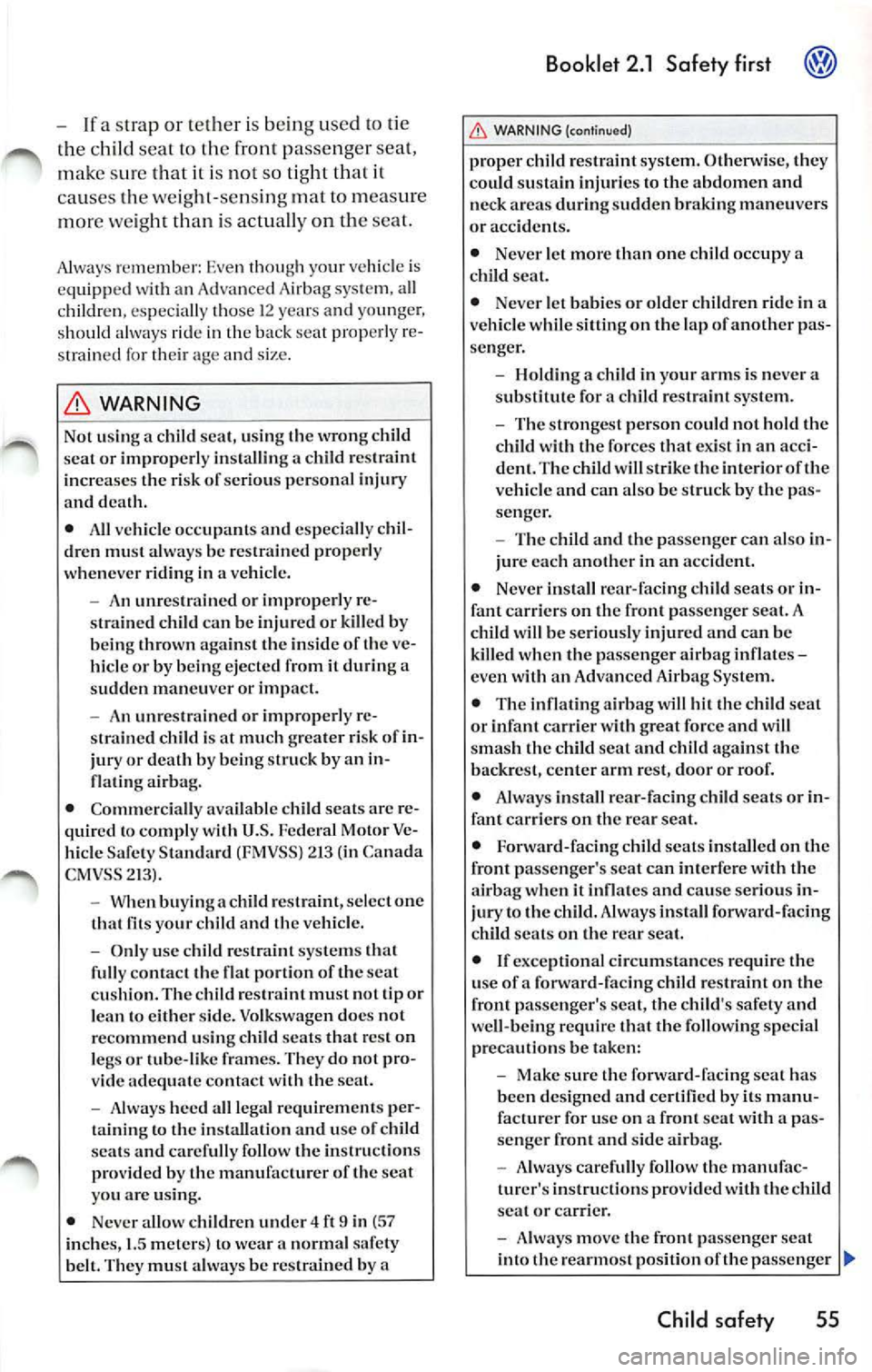
-If a strap or te ther is being use d to tie
th e ch ild sea t to th e front passenge r seat,
ma ke s ure that it is
no t so tight that it
ca uses the we ight -sensin g mat to meas ure
more weig ht th an is actuall y on the se at.
Always remember: Even though yo ur vehicle is
e quip ped w ith an Advanced Airbag sys te m. all
c hildr en, especia lly those 12 years a nd youn ger,
s h ould always ride in the ba ck sea t p roper ly re
s train ed for th eir age and size.
WARNING
Not using a child sc a t, u si ng th e wrong child
s eat or improp erly insta llin g a c hild r estraint
in creases the risk of se riou s personal injury
and dea th.
• All ve hicle occupants and especia lly chil
dr en must alway s be res train ed properl y
whenever riding in a ve hicl e.
-
unr estrain ed or improperl y re
s trained child can be injur ed or kill ed by
b ein g thrown against the insid e of th e ve
hicle or by being ejected from it during a
s udd en man euver or imp act.
-
unrest rained or improperly re
stra ined ch ild is at much greater risk of in
jur y or death by being stru ck b y an in
fl atin g ai rbag.
• Comm ercia lly ava ilabl e child seats are re
quir ed t o co mply with U.S. Federal Motor Ve
hicle Safe ty Sta ndard (FMVSS) 2 13 (in Canada
CMVSS2 13).
- Wh en buying a child re straint , selec t one
that
y our child and the vehicle.
- Onl y use child restraint syste m s that
full y contact the flat portion of
seat
cushion. The child restraint must not tip or
lean t o either side. Volkswag en do cs not
r eco mmend using child scats that r es t on
l egs o r tube -lik e fram es. They do not pro
vide adequate co ntact with the scat.
- Always hee d all legal r equirem ent s per
t a inin g to the in stallati on an d u se of ch ild
sc ats and care fully follo w the in structions
pro vided by the manufacturer of the seat
yo u arc usin g.
• Neve r allow childr en und er 4 ft 9 in (57
in che s, 1.5 met ers) to wear a normal safety
belt. They must always be restr ained b y a
Booklet 2.1 Safety first
WARN ING (continu ed)
proper child re straint system. Oth erw ise, they
c ould susta in injurie s to the abdomen and
ne ck ar eas during sudden braking maneuvers
or accidents.
• Never let more than one child oc cupy a
child scat.
• Neve r let babi es or older chil dre n ride in a
ve hicle while sittin g on the lap of anoth er pas
se nge r.
- Holding a child in your arms is neve r a
sub stitute for a child restraint system.
- The strongest person could not hold the
c hild with the forces that exis t in an acci
dent. The child will strik e th e int eri orof the
ve hicl e and can al so be s tru ck by the pa s
senger.
- The child and th e passenge r ca n also in
jur e each another in an accident.
• Ne ver install rear-faci ng child seat s or in
fant carriers on the front passe nge r sea t.
w ill b e se riou sly injur ed and can be
killed when the passenger airbag inflates
even with Advanced Airbag System.
• The i nflating airb ag w ill hit th e child scat
o r infant carrier w ith great force and will
s mash th e child scat a nd child against the
backr est, ce nter arm res t, d oo r or roof.
• Alwa ys insta ll rear-facing child scats or in
fant carri ers on the r ear seat.
• Forward-facing child seats insta lled on th e
front pa ssenger 's sca t can interfer e with th e
a irb ag w hen it inflate s an d cau se se riou s in
ju ry to th e child . Always install forward-facing
c hild scats on the rear seat.
• I f exce ptional circumstance s requir e th e
u se of a forward-facing child res traint on the
front pa ssenger's scat, th e c hild 's safet y and
we ll-be ing require that the following sp ecia l
pr ecaut ions be taken:
- Make sur e the fonvard-facing seat ha s
been des ig n ed and
by its manu
factur er for use on a front scat with a pas
se nger front and side airba g.
- Always carefully follow the manufac
tur er's instru ction s pro vid ed w ith th e child
sea t or carrier.
- Always move the front pa ssenger seal
into th e rearmo st position
pass enger
Child safety 55